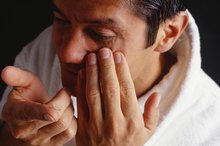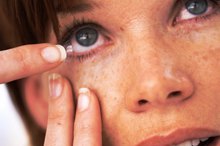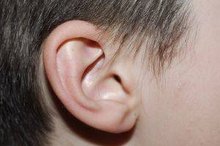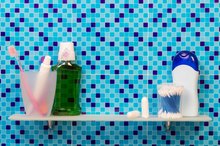What does fact checked mean?
At Healthfully, we strive to deliver objective content that is accurate and up-to-date. Our team periodically reviews articles in order to ensure content quality. The sources cited below consist of evidence from peer-reviewed journals, prominent medical organizations, academic associations, and government data.
The information contained on this site is for informational purposes only, and should not be used as a substitute for the advice of a professional health care provider. Please check with the appropriate physician regarding health questions and concerns. Although we strive to deliver accurate and up-to-date information, no guarantee to that effect is made.
Other Uses for Contact Solution
To look at a bottle of plain contact solution, you may never guess its many off-label uses. This is not to be confused with multipurpose contact solution -- only bottles marked contact solution or saline solution. Even for those who do not wear contacts, a little bottle of this doctor office and hospital staple is a must-have for the household.
If you are experiencing serious medical symptoms, seek emergency treatment immediately.
First Aid
Keep an unopened bottle of contact solution in your first aid kit. It can be used to irrigate debris, cleanse wounds, as eye wash, and to sooth burns. This can be done by opening the bottle and spraying the solution directly on the wound until it is free of dirt and contaminates. The opening of the bottle should never come in contact with either the wound or any skin surface. If it does, do not re-cap for later use; it is no longer sterile. Replace with a new bottle if it becomes contaminated.
- Keep an unopened bottle of contact solution in your first aid kit.
- The opening of the bottle should never come in contact with either the wound or any skin surface.
Nasal Irrigation
How to Save a Dried Out Contact
Learn More
Saline solution for nasal congestion, sold in most drug stores, is the same solution found in plain contact solution. Used as a nasal wash contact solution, it can help remove mucus from the nose and nasal passages. Preform a nasal wash by spraying it directly into your nose several times a day to alleviate congestion. Contact, or saline, solution is not harsh on your nasal passages as most over-the-counter nasal sprays. According to the University of Maryland Medical Center, researchers found that a daily irrigation of nasal passages with saline solution relieves sinusitis symptoms and reduces antibiotic use.
- Saline solution for nasal congestion, sold in most drug stores, is the same solution found in plain contact solution.
- Used as a nasal wash contact solution, it can help remove mucus from the nose and nasal passages.
Ear Wash
Excess earwax build-up, or impaction in the ear, can be washed out with contact solution. Mix one part hydrogen peroxide to one part contact solution. Have the person lie on his side with the non-affected ear facing up. Drape a towel over him to protect his clothing. Use a sterile bulb syringe, or regular sterile syringe, and spray an continuous stream of the mixture into the affected ear. The wax build-up bubbles to the surface allowing you to wipe it away.
- Excess earwax build-up, or impaction in the ear, can be washed out with contact solution.
Eye Drops or Contact Re-wetting Solution
How to Wear a Toric Contact Lens
Learn More
Plain contact solution, especially thimerisol-free, can be used as eye drops or re-wetting solution. You never want to put multipurpose solution directly into your eye. Label your container "contact solution" or "saline solution." Since most bottles tend to be larger in size than regular eye drop bottles, making them hard to carry around, you may transfer contact solution into another sterile container. When using eye drops, the tip of the bottle should not touch your eyeball or eyelid; this can transfer contaminates into the container. If at anytime your eye becomes irritated, discontinue use immediately.
- Plain contact solution, especially thimerisol-free, can be used as eye drops or re-wetting solution.
- When using eye drops, the tip of the bottle should not touch your eyeball or eyelid; this can transfer contaminates into the container.
Related Articles
References
- “Contact Lens Care Systems & Solutions.” Centers for Disease Control and Prevention, Centers for Disease Control and Prevention, 9 Apr. 2020, www.cdc.gov/contactlenses/care-systems.html.
- “Update on Scleral Lenses.” American Academy of Ophthalmology, 27 May 2020, www.aao.org/eyenet/article/update-on-scleral-lenses.
- Kilvington S, Huang L, Kao E, Powell CH. Development of a new contact lens multipurpose solution: Comparative analysis of microbiological, biological and clinical performance [Desarrollo de una nueva solución multiusos para lentes de contacto: análisis comparativo de su rendimiento microbiológico, biológico y clínico]. J Optom. 2010;3(3):134-142. doi:10.1016/S1888-4296(10)70019-4
- “Acanthamoeba Keratitis FAQs.” Centers for Disease Control and Prevention, Centers for Disease Control and Prevention, 2 Nov. 2010, www.cdc.gov/parasites/acanthamoeba/gen_info/acanthamoeba_keratitis.html.
- “Lens Care.” American Optometric Association, www.aoa.org/patients-and-public/caring-for-your-vision/contact-lenses/lens-care.
Writer Bio
Christina Floyd has been a full-time writer since 2009. She has had articles published in "The Bavarian News" and "The Schweinfurt Dispatch." Floyd's expertise includes the medical field, creative writing and the military lifestyle. She has been a student in alternative and herbal therapies since 2010.









